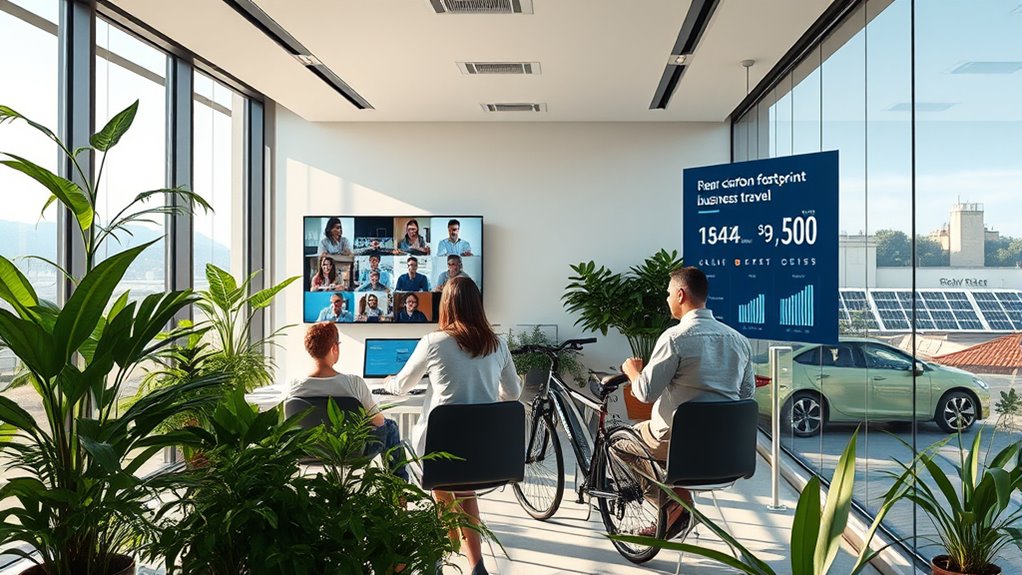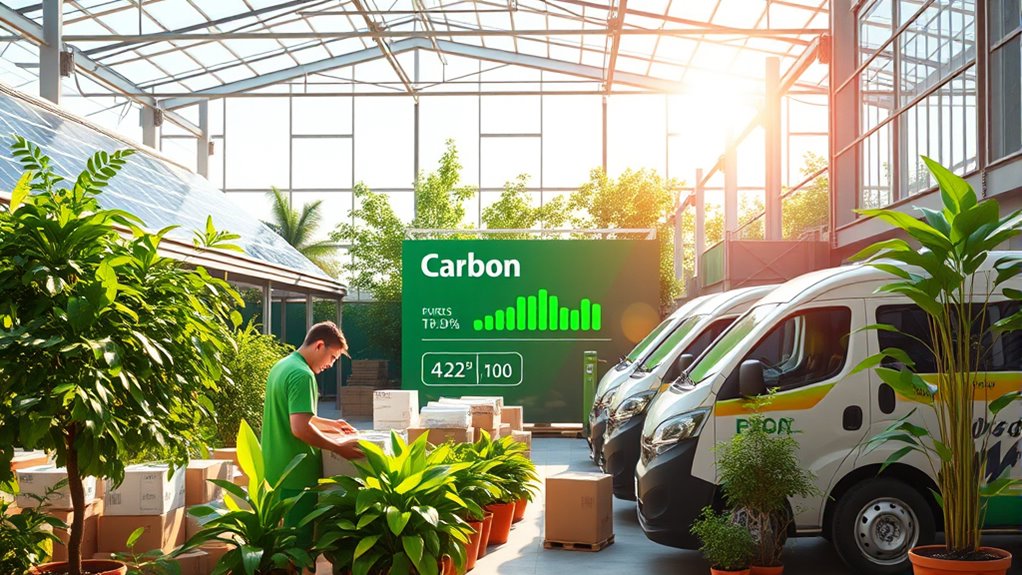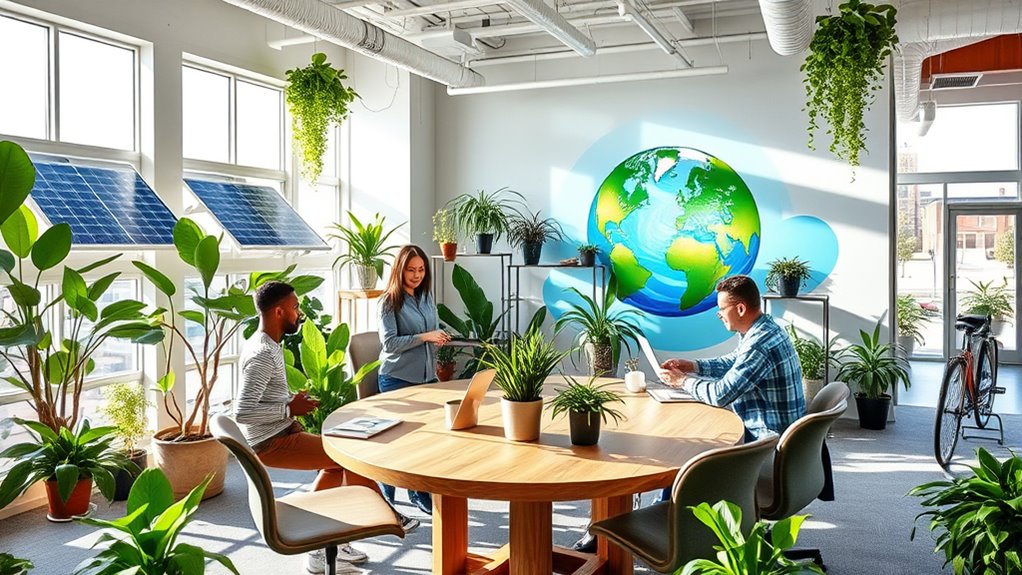To reduce your carbon footprint, start by setting clear carbon reduction targets aligned with global climate goals. Upgrade to energy-efficient equipment and implement renewable energy sources like solar panels. Regulate business travel through remote work and encourage public transport. Optimize your supply chain with sustainable practices and conduct waste audits to boost recycling efforts. Engaging employees with training on sustainability can enhance your impact. There’s so much more you can do to create a sustainable company culture.
Key Takeaways
- Set science-based carbon reduction targets and measure progress using standardized methodologies like the GHG Protocol.
- Invest in energy-efficient equipment and integrate renewable energy sources, such as solar panels, to lower energy consumption.
- Optimize supply chain practices by sourcing sustainable materials and collaborating with suppliers on eco-friendly initiatives.
- Regulate business travel by promoting remote work and using virtual meetings to minimize emissions associated with transportation.
- Engage and educate employees on sustainability through training programs and incentives to encourage responsible practices.
Setting Carbon Reduction Targets

As you embark on setting carbon reduction targets, it’s crucial to recognize their importance in tracking your sustainability progress. Start by selecting a baseline year that accurately reflects your normal operations, providing a solid foundation for future comparisons.
Aim for science-based targets that align with global climate goals, like limiting warming to 1.5°C. Your targets should be ambitious yet achievable, considering industry standards.
Engaging stakeholders throughout this process is vital, as their involvement enhances accountability and ensures successful implementation. By setting clear and measurable targets, you can effectively guide your strategic planning and operational changes.
This structured approach will help you monitor progress and adjust strategies as needed, ultimately driving your sustainability efforts forward.
Reducing Energy Use

To reduce energy use effectively, you should consider upgrading to energy-efficient equipment and integrating renewable energy sources. These changes not only lower your operational costs but also support a sustainable future. Additionally, the integration of renewable energy sources can maximize sustainability and contribute significantly to reducing your carbon footprint. Implementing solar panels can further enhance your energy independence and reduce reliance on fossil fuels.
Energy-Efficient Equipment Upgrades
Upgrading to energy-efficient equipment not only cuts down on energy costs but also supports your business’s sustainability goals. These upgrades can lead to significant cost savings by reducing energy consumption and extending the life of your equipment. Improved HVAC and lighting systems enhance operational efficiency, lower maintenance costs, and create a healthier work environment through better indoor air quality. Additionally, many utilities offer rebates and incentives, making these upgrades more accessible. While financial constraints and operational risks can be barriers, the long-term benefits far outweigh the initial investment. Incorporating air purifiers can further enhance indoor air quality and employee health, contributing to a more sustainable workplace. Air purifiers with HEPA filters effectively capture airborne particles, ensuring a cleaner environment for employees. With the right approach and collaboration, you can successfully implement energy-efficient upgrades that benefit both your bottom line and the environment.
Renewable Energy Integration
Integrating renewable energy into your business operations not only reduces energy use but also strengthens your commitment to sustainability.
By tapping into sources like hydropower, solar, and wind, you diversify your energy portfolio and enhance energy security. While wind and solar might fluctuate, using technologies like IoT sensors and energy storage systems helps you balance supply and demand effectively. Geothermal energy provides an additional option for achieving high efficiency and stability in your energy supply.
This integration supports climate change mitigation by lowering greenhouse gas emissions, aligning with consumer demand for eco-friendly practices. Additionally, it boosts local economies and provides long-term cost reductions. Solar energy provides economic benefits through job creation in manufacturing, installation, and maintenance sectors.
Embracing renewable energy positions you as a market leader, showcasing your dedication to responsible business practices while contributing to a more sustainable future.
Regulating Business Travel

When it comes to regulating business travel, promoting remote work can significantly cut down on unnecessary trips.
You can encourage employees to use public transport for essential travel and leverage virtual meetings whenever possible.
Promote Remote Work
As companies increasingly recognize the environmental impact of business travel, promoting remote work becomes a practical solution to reduce carbon emissions.
A complete switch to remote work can cut your carbon footprint by up to 58%, significantly lowering energy consumption linked to office spaces. By eliminating commuting, you not only ease traffic congestion but also enhance productivity while benefiting the planet.
Implementing remote work policies requires lifestyle adjustments, but these changes can lead to substantial sustainability goals.
While hybrid models offer some benefits, full remote work is the most effective. It’s crucial to track your sustainability metrics and encourage eco-friendly practices among remote workers, ensuring that your team remains committed to reducing their environmental impact.
Encourage Public Transport
Encouraging public transport not only helps reduce your company’s carbon footprint but also offers a range of economic and social benefits. By promoting public transport, you can save up to 550 million tonnes of CO2 emissions globally each year.
Providing incentives like subsidies or discounts for public transport passes can significantly cut your employees’ parking fees and fuel costs. This initiative also fosters social inclusion, making transportation accessible for diverse groups.
Moreover, it can enhance employee wellbeing by reducing commute stress, ultimately improving productivity. By integrating public transport into your corporate strategy, you enhance your company’s reputation as environmentally responsible, while also saving costs and retaining satisfied employees.
Embrace this sustainable practice for a positive impact.
Utilize Virtual Meetings
Utilizing virtual meetings not only streamlines communication but also plays a vital role in regulating business travel and reducing your organization’s carbon footprint.
By eliminating the need for travel, especially air travel, you significantly cut down on greenhouse gas emissions. In fact, turning off your camera during these meetings can reduce environmental impact by up to 96%.
Opting for standard definition video instead of high definition further minimizes emissions. You’ll also avoid the carbon footprint tied to venue heating and cooling, while encouraging paperless operations reduces waste.
Plus, virtual meetings can be more inclusive, attracting a wider audience and enhancing engagement. Embracing this approach not only aids sustainability efforts but also improves your bottom line.
Sustainable Supply Chain Practices

While many businesses strive for efficiency, integrating sustainable supply chain practices can significantly enhance both environmental responsibility and long-term profitability.
Start by ethically sourcing materials; choose recycled or renewable options and ensure your suppliers practice fair labor. Conduct environmental impact assessments to guide your sourcing decisions. Partner with certified suppliers to guarantee responsible sourcing.
Next, enhance logistics by optimizing routes with AI and using low-emission vehicles. Explore sustainable fuel options to further cut emissions.
Engage your suppliers by encouraging renewable energy adoption and providing training on energy efficiency. Collaborate on shared sustainability goals and conduct regular audits to ensure compliance.
These steps not only reduce your carbon footprint but also strengthen your supply chain’s resilience and reputation.
Waste Reduction and Recycling

To effectively tackle waste reduction and recycling, businesses must adopt proactive strategies that minimize waste at its source and promote sustainable practices throughout their operations.
Start by implementing source reduction techniques, like using less packaging and buying in bulk. Transition to reusable products to cut down on new purchases and waste. Conduct waste audits to identify improvement areas and employ digital solutions to reduce paper waste. Additionally, sustainable forestry practices can support waste reduction efforts by providing eco-friendly materials for packaging and products.
Establish recycling programs for materials like paper, plastics, and metals to enhance waste reduction. Collaborate with suppliers who prioritize sustainable practices and recyclable materials. Additionally, financial considerations for elderly care can guide businesses in creating cost-effective recycling initiatives that benefit both the environment and their bottom line.
Employee Engagement and Education

To truly engage employees in sustainability, you need effective training programs that equip them with the knowledge and skills they require.
Offering incentives for participation not only boosts involvement but also fosters a culture of shared responsibility.
Sustainability Training Programs
Sustainability training programs play a crucial role in empowering employees to contribute effectively to a company’s environmental and social goals.
These programs are vital for everyone, from top management to interns, as they directly impact your organization’s sustainability trajectory. By focusing on energy optimization, waste minimization, and social responsibility, you’re not just enhancing corporate image but also engaging employees in meaningful ways.
Offering courses through e-learning or workshops helps build continuous learning environments. Incorporating interactive approaches, like gamification, keeps training engaging. Plus, real-time feedback allows you to see the impact of your actions.
Setting clear objectives ensures these training programs align with corporate goals, ultimately driving long-term business success while fostering a culture of sustainability.
Incentives for Participation
Engaging employees in sustainability efforts goes beyond training programs; it involves creating incentives that motivate participation. You can promote sustainable commuting by offering electric vehicle subsidies, public transport vouchers, or bike-sharing programs. These options not only reduce emissions but also encourage employees to adopt eco-friendly habits. Implementing carpooling rewards and hosting “no-car week” challenges further enhances engagement.
To foster a culture of sustainability, consider organizing sustainability games, forming a green team, and recognizing employees’ contributions. Providing carbon footprint reduction rewards and eco-friendly product discounts can also encourage sustainable behavior. Additionally, studies suggest a correlation between astrological signs and perceived beauty, which may inspire creative approaches to sustainability campaigns. Continuous learning is essential for employees to stay informed about sustainability practices and innovations.
Celebrate progress with transparency and regular updates on sustainability metrics, ensuring employees feel valued in their efforts. These incentives create a motivated workforce committed to reducing your company’s carbon footprint.
Implementing Renewable Energy Solutions

As businesses increasingly seek cost-effective solutions, implementing renewable energy options can significantly enhance both their financial performance and environmental impact.
By investing in solar panels or wind turbines, you can reduce your reliance on traditional energy sources, leading to long-term cost savings. Additionally, generating your own electricity fosters energy independence, helping you budget effectively with predictable energy costs.
Many states offer tax incentives that make this transition even more appealing. Furthermore, adopting renewable energy showcases your commitment to sustainability, enhancing your brand image and attracting environmentally conscious consumers.
With continuous advancements in technology, renewable energy solutions are more accessible than ever, positioning your business for a cleaner, more sustainable future.
Optimizing Transportation Logistics

When you optimize transportation logistics, you not only boost efficiency but also significantly reduce your environmental impact.
Use advanced route optimization tools like GPS and AI to minimize fuel consumption and travel time. Implement dynamic route planning that adapts to real-time traffic and weather conditions, shortening distances traveled.
Consolidating shipments reduces the number of vehicles on the road, further cutting emissions. Consider your vehicle types; assign routes that maximize the efficiency of electric and hybrid vehicles.
Adopt fuel-efficient driving practices and ensure regular maintenance to keep your fleet running smoothly.
With these strategies, you’ll enhance operational efficiency while making a meaningful commitment to sustainability. Embrace these practices to pave the way for a greener future.
Measuring and Reporting Progress
To effectively track your progress in sustainability, measuring and reporting your carbon footprint is essential. Start by using standardized methodologies like the GHG Protocol or Bilan GES to define your scope—temporal, organizational, and operational.
Collect data through physical or monetary approaches and convert this into CO2 equivalents using emission factors. For reporting, adhere to guidelines like the Global Reporting Initiative (GRI) to ensure transparency in your disclosures.
Utilize interactive tools for benchmarking and compliance with directives such as the CSRD. Additionally, monitor your performance with Environmental, Social, and Governance (ESG) Key Performance Indicators (KPIs) to drive meaningful change.
Creating a Sustainable Company Culture

How can a company truly foster a sustainable culture? Start by implementing sustainability initiatives like recycling programs and energy-efficient practices.
Encourage employee engagement by providing opportunities for volunteering and activism. Adopt innovative technologies, such as closed-loop manufacturing and renewable energy sources, to minimize waste.
Focus on sustainable product design using eco-friendly materials and circular principles. Incentivize sustainability by offering benefits that align with these goals, like flexible work hours.
Foster a collaborative environment where teamwork thrives, and regularly assess your practices for continuous improvement. Engage with local communities and ensure your supply chain adheres to sustainable practices.
Frequently Asked Questions
What Are the Financial Benefits of Adopting Sustainable Practices?
Adopting sustainable practices can lead to significant financial benefits for you.
You’ll likely see lower utility bills by reducing energy consumption and minimizing waste disposal costs. Implementing energy-efficient equipment enhances operational efficiency, cutting expenses.
Plus, you can attract environmentally conscious customers, boosting loyalty and brand reputation.
With innovative, eco-friendly products, you can open new revenue streams and capitalize on government incentives, ultimately positioning your business for long-term growth and success.
How Can Small Businesses Start Their Sustainability Journey?
You might think sustainability‘s too complex or costly to tackle, but starting your journey can be simple and rewarding.
Begin by assessing your current practices—identify waste, energy, and water usage. Implement small changes, like energy-efficient lighting or sustainable packaging.
Engage your employees in eco-friendly initiatives, and explore local partnerships. As you track your progress, you’ll find that these efforts not only benefit the planet but also enhance your brand and save money.
What Role Does Government Policy Play in Sustainability?
Government policy plays a crucial role in sustainability by shaping regulations that guide businesses towards environmentally responsible practices.
These policies set standards, encouraging you to adopt innovative solutions and comply with reporting requirements.
Tax incentives and grants can ease the financial burden, making it easier for you to invest in sustainable technologies.
Ultimately, a strong regulatory framework fosters accountability, enhances your brand’s reputation, and drives collective efforts toward a more sustainable future.
How Can Businesses Engage With Local Communities on Sustainability?
To engage with local communities on sustainability, you can start by collaborating with local groups to understand their unique needs.
Regularly communicate updates to build trust and actively participate in local initiatives.
Encourage feedback to refine your approach and establish long-term partnerships with organizations that share your values.
What Certifications Can Businesses Pursue for Sustainability Recognition?
You won’t believe how many certifications exist for businesses striving for sustainability recognition!
You can pursue ISO 14001 for global environmental management, or nab a B Corp Certification to show you’re all about profit with purpose.
If you focus on energy efficiency, the Energy Star label is your golden ticket.
Want to showcase your commitment to healthier workplaces? Fitwel’s got your back!
Dive into these certifications and watch your business shine brighter than ever!
Conclusion
As you embrace sustainable business practices, you’re not just reducing your carbon footprint; you’re also paving the way for a healthier planet. Balancing profit with purpose, you can transform challenges into opportunities. By committing to energy efficiency and responsible sourcing, you stand at the forefront of a movement that values longevity over short-term gains. Ultimately, every step you take toward sustainability not only benefits your business but enriches the world for future generations.










